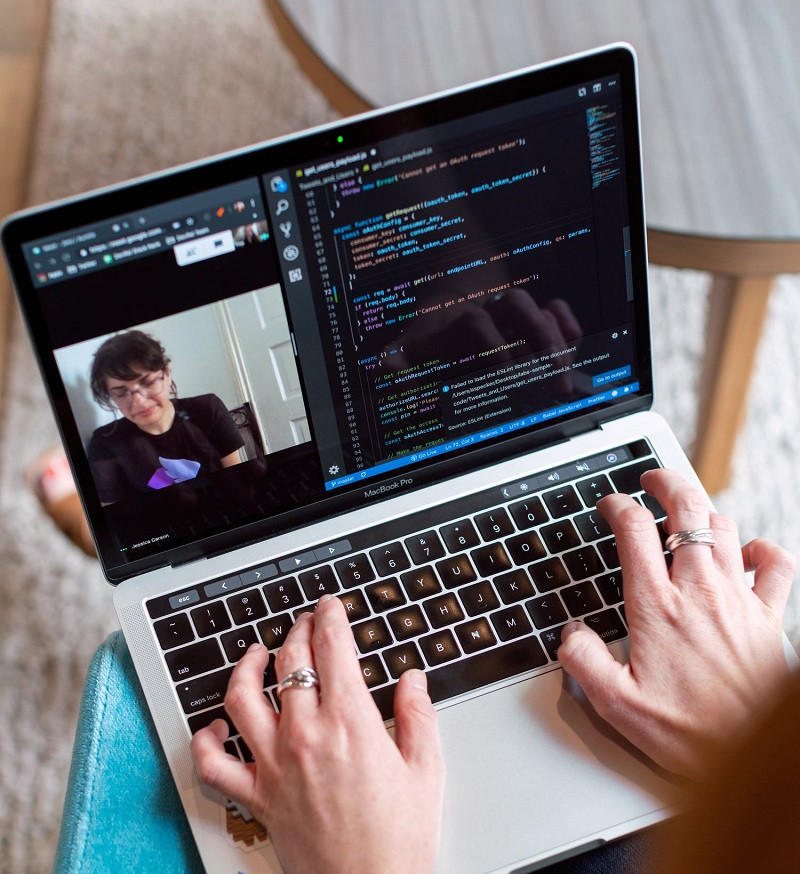With the arrival of the pandemic and working from home, some unexpected phenomena for mental health have begun to occur, such as Zoom fatigue
Throughout this article we will see what it is and how it affects us in a context in which video calls are increasingly normalized.
What is Zoom fatigue?
Let’s start by defining the term “Zoom fatigue.” This refers to a psychological phenomenon characterized by the feeling of tiredness and lack of energy after having spent the entire day in the middle of video conferences or being people observed through a camera.
This situation seems to be not only the result of the time spent in the middle of these activities, but there is also an impact on other factors. Below, we explore some of them and some options to avoid it.
Causes
These are the main causes of Zoom fatigue.
1. Camera presence
According to a study whose results have been published in the Journal of Applied Psychology under the title “The fatiguing effects of camera use in virtual meetings: A within-person field experiment”, Having the camera on in virtual meetings can cause Zoom fatigue This fact may be related to the need to show a professional image in front of co-workers and superiors, and to a feeling of constant observation that is not the same as that which occurs in the midst of face-to-face work.
In real life, you can avoid the pressure of feeling watched by unfamiliar or unfamiliar people by looking elsewhere or at the ground, as you would when you are in the elevator. In the work context, the space is distributed so that people are not looking at each other’s faces all the time and only some interactions are generated between some subjects.
But in the middle of a virtual meeting, all the faces are projected on the screen, and there is an observation of all the participants among themselves, creating a sensation comparable to being on a bus being observed by all the passengers, which contributes to the experience. to be evaluated by others.
Having the camera on also generates heightened self-awareness, leading to thinking about the image that is being projected to all the spectators of the meeting You may also feel pressure to constantly observe the speaker or meeting host to avoid giving a bad impression.
Furthermore, the non-verbal signals of the participants can be a source of confusion and anxiety for all participants in the events, since the gestures and expressions become poorly understood in the absence of a context to interpret them and not knowing who they are directed at or What situation generated them.
2. Looking at a mirror throughout the day
A situation that occurs in Zoom sessions or in any other video conferencing platform has to do with the fact of observing one’s own image for most of the time during the interaction with the other (unless the option is chosen to hide this image, which is determined with the program).
This increases the chances of judging yourself more frequently , which could be positive for some people to improve their appearance or behaviors, but in many other cases it can be a source of stress. This situation tends to affect women more strongly than men, who may direct negative attention toward themselves. However, constant observation could also affect men.
3. Stimulus overload
In relation to the previous factor, you can find the difference that exists between in-person non-verbal communication and non-verbal communication in the midst of virtuality. In in-person interactions, facial and body gestures flow more easily and you rarely think about what you are communicating. However, Through virtual meetings, excessive awareness can be generated about what is being communicated through non-verbal language and there is a much higher demand for cognitive resources to compensate for those limitations of the virtual format of the interaction.
In online interactions, not only do you need to make an effort to be present and communicate a message naturally as you would do in person, but you also need to arrange the space in which the person will be located, configure the camera to record a certain space, think about the gestures that will be made and whether they will be framed in the image that the interlocutor receives, and constantly observe the camera to give the notion that one is looking at the interlocutor in the eyes, something that in the long run becomes unnatural and requires deliberate efforts. These actions also lead to more errors in the middle of communication, thus contributing to Zoom fatigue.
4. Body causes of fatigue
To maintain one’s own image in the field of vision of the people attending the conferences required to sit still in a chair for most of the day
Most people tend to be close to the screen and keyboard for many minutes at a time, which can be a contributing factor to people’s fatigue. In the case of video calls, people may feel that, due to various cultural norms, they must place themselves in a position where they are visible to their co-workers, which adds an additional factor to the discomfort generated by the psychological factors that we have discussed. seen.

- You may be interested: “Emotional fatigue: strategies to confront and overcome it”
Consequences and psychological effects
An important consequence is that the fatigue generated by virtual meetings has an impact on the expression of voice and the commitment of workers or students, which is reflected in a lack of contributions, and a desire to participate in online meetings
This occurs as a result of voice expression and engagement being some behaviors that can be evaluated and judged by coworkers, which can lead people to avoid speaking or appearing “engaged” with the topics developed in the conferences so as not to be able to be evaluated
At the same time, fatigue demands cognitive resources, and this makes it difficult for people to focus on the expression of their voice or the commitment they show in virtual meetings with other people.
The discomfort is not directly related to the meetings attended per day
One might think that the phenomenon is related to the various meetings that people have to attend on the same day. However, some studies have indicated that although the number of people attending virtual meetings has increased exponentially since the arrival of the pandemic and working from home, Meeting duration has decreased by 11.5 percent compared to in-person meetings
Women and new employees are the most affected
It has been observed that women are more affected by Zoom fatigue due to a sense of increased pressure to meet social standards of beauty and presentation and competence to perform.
New employees may feel pressure to present a better image to keep their job and to avoid giving a beginner image
What can be done to combat this phenomenon?
Sometimes it becomes impossible to turn off the camera as a result of the policies of the institutions we are in; However, there are some practices that can help.
1. Take small breaks
Taking into account the consequences of observing one’s own image and that of others throughout the day, an appropriate action that can be taken is minimize the window of the virtual meeting that is being observed or move your gaze and change position
It is possible that all coworkers will feel the same psychological and bodily effects in the midst of virtual meetings and will therefore understand the need to change position or move for a moment to avoid the effects of this phenomenon.
2. Reduce the stimuli present on the screen
According to the studies presented above, a major cause of Zoom fatigue lies in a heightened awareness of what others will think of us, heightened by the image of ourselves on the screen.
A tip for this situation can be to hide your own image on Zoom or any other video calling platform that is being used.
Another useful tip is avoid focusing on the stimuli presented in the classmates’ videos like the environment in which they are found.
3. Make the use of the camera optional and plan an agenda
If you are in an executive position, it may be appropriate to make the use of the camera optional in meetings because fatigue can be increased on occasions when the space is being shared with many people and some are strangers.
It may also be appropriate to have a facilitator who helps develop communication in large groups, facilitating the creation of points in meetings and moments in which people should speak. This can avoid the negative consequences of constantly analyzing what others will think of the contributions made, thus reducing the negative consequences of Zoom fatigue.









